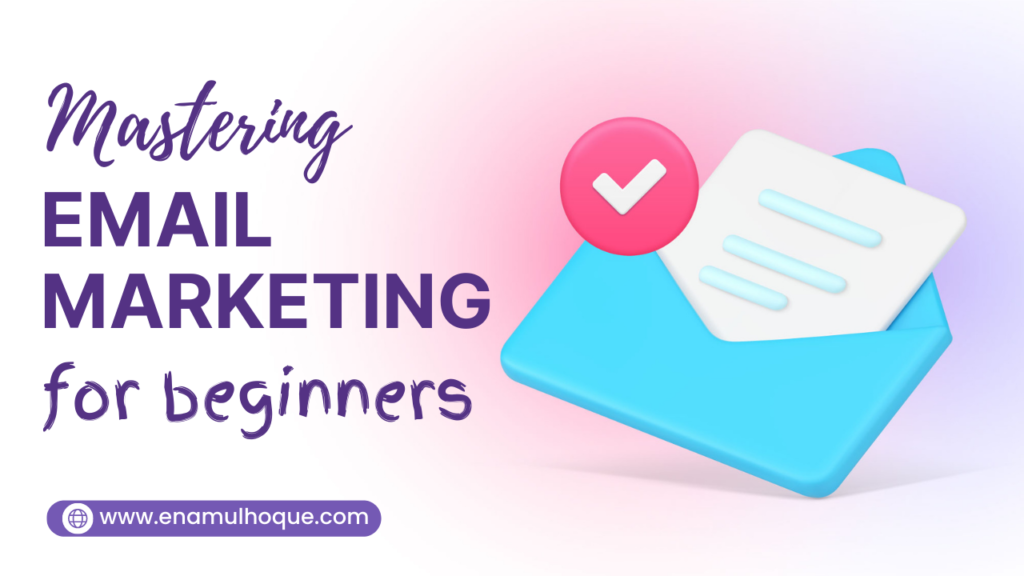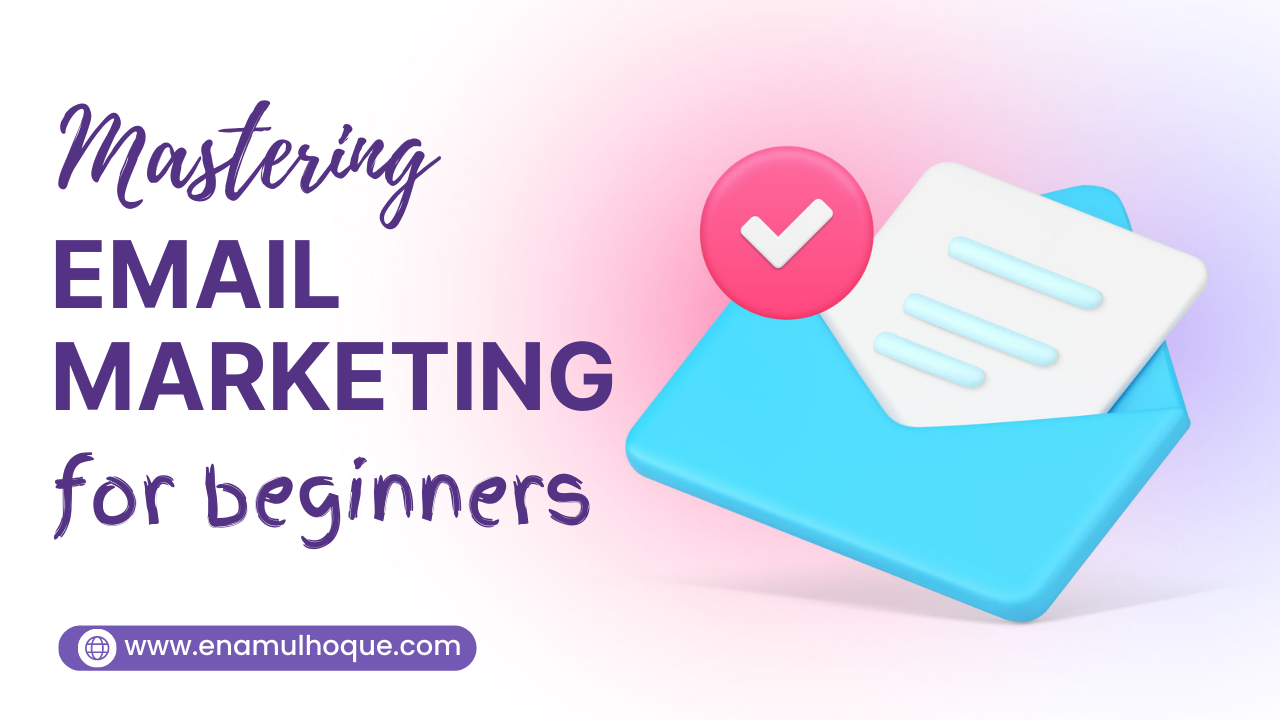Email marketing is a powerful tool used by businesses to reach and engage with their target audience through email campaigns. In this article, we will explore the basics of email marketing for beginners, including the benefits, best practices, and tips to get started.
Email marketing is a highly effective marketing strategy that involves sending targeted emails to prospects and customers. It allows businesses to build relationships with their audience, promote products or services, and drive sales. With the right approach, email marketing can generate a high return on investment and help businesses achieve their marketing goals.
In this beginner’s guide to email marketing, we will cover all the essential elements you need to know to launch successful email campaigns. From building an email list and creating engaging content to tracking results and optimizing your campaigns, you will learn the key strategies and tactics to drive results with email marketing. So let’s dive in and discover the power of email marketing for your business.
My Best Recommended & Proven Way to Make $100-$500 Per Day – Watch THIS FREE Video to START >>
Introduction To Email Marketing
Email marketing is a powerful tool that can greatly contribute to business growth. In today’s digital age, where people are constantly connected to their email accounts, leveraging email marketing can significantly boost your customer reach and engagement. With an effective email marketing strategy in place, you can convey your message directly to your audience, increase brand awareness, and build lasting relationships with your customers.
Let’s dive into the importance of email marketing for business growth and the benefits of incorporating power words in your email marketing campaigns.
Understanding Power Words
Email marketing is a powerful tool when it comes to reaching your target audience and driving conversions. However, crafting emails that grab the reader’s attention can be a challenge. This is where power words come in. Power words are persuasive and emotionally charged terms that can trigger a desired response from your audience.
In this section, we’ll explore the definition and purpose of power words, as well as provide examples of effective power words for email marketing.
Definition And Purpose Of Power Words
- Power words are persuasive terms that evoke strong emotions and create a sense of urgency or excitement.
- They can be used in subject lines, headlines, call-to-action buttons, and body copy to grab attention and drive action.
- The purpose of power words in email marketing is to compel readers to open your emails, engage with your content, and ultimately take the desired action, whether it’s making a purchase, signing up for a newsletter, or downloading a resource.
Examples Of Effective Power Words For Email Marketing
- Urgency: Limited-time offer: flash sale ends tonight!
- Exclusivity: Vip access: be the first to get exclusive discounts.
- Curiosity: Secrets revealed: discover the key to success.
- Benefit-driven: Transform your life with our revolutionary product.
- Personalization: Your personalized plan is ready just for you.
- Trust-building: Recommended by experts: trusted by thousands.
- Social proof: Join our community of satisfied customers.
- Relevance: Boost your productivity in just 10 minutes per day.
- Emotional: Experience the joy of a clutter-free home.
- Call-to-action: Claim your free trial now: don’t miss out!
Incorporating power words into your email marketing campaigns can have a significant impact on your open rates, click-through rates, and conversions. Experiment with different power words and track the results to find the ones that resonate most with your audience.
Remember, the key is to strike a balance between using power words effectively and maintaining authenticity in your email communications. So go ahead and add some power to your emails to amplify your marketing efforts!
Crafting Attention-Grabbing Subject Lines
Email marketing is a powerful tool that allows businesses to connect with their audience in a direct and personalized way. One of the most crucial elements in email marketing is the subject line. It’s the first thing that recipients see in their inbox, and it can determine whether they open the email or not.
Crafting attention-grabbing subject lines is essential to capturing the reader’s interest and increasing open rates. In this section, we will explore the importance of subject lines in email marketing and techniques to create compelling subject lines using powerful words.
Importance Of Subject Lines In Email Marketing:
- The subject line is like the cover of a book – it determines whether the reader will click to open the email or ignore it.
- A catchy and intriguing subject line can pique the reader’s curiosity and make them want to know more.
- Personalization in subject lines can make the recipient feel valued and increase their likelihood of opening the email.
- Subject lines should convey the main benefit or value proposition of the email to entice the recipient to take action.
- They should also create a sense of urgency or exclusivity to drive immediate action.
- A well-crafted subject line can help improve open rates, click-through rates, and overall engagement with your email campaigns.
Techniques To Create Compelling Subject Lines Using Power Words:
- Use power words that evoke emotions and capture attention, such as “exclusive,” “limited time,” “discover,” or “amazing.”
- Ask a compelling question that sparks curiosity or addresses a pain point, such as “are you making these common marketing mistakes?”
- Incorporate numbers or statistics to add credibility and make the subject line more specific and enticing, for example, “5 proven strategies to boost your sales.”
- Personalize subject lines by including the recipient’s name or other relevant information to make them feel special and increase the likelihood of opening the email.
- Keep subject lines short, clear, and to the point, avoiding lengthy or vague phrases.
- A/b test different subject lines to see which ones resonate best with your audience, and use data to refine your approach.
Crafting attention-grabbing subject lines is an art that requires understanding your audience and experimenting with different techniques. By using powerful words, personalizing subject lines, and creating a sense of urgency, you can increase your chances of capturing your audience’s attention and achieving email marketing success.
Creating Persuasive Email Body Content
Email marketing is a crucial tool for businesses to connect with their audience and drive conversions. One of the key aspects of a successful email campaign is creating persuasive email body content that engages readers and compels them to take action.
In this section, we will explore how to structure email body content for maximum impact and incorporate power words to increase reader engagement and conversion. So, let’s dive in and discover the secrets to crafting compelling email content that gets results.
Structuring Email Body Content For Maximum Impact
When it comes to structuring your email body content, it’s essential to keep it clear, concise, and engaging. Here are some key points to consider:
- Start with a compelling subject line: Grab your reader’s attention right off the bat with a subject line that piques their curiosity or offers a valuable benefit. This will entice them to open your email and continue reading.
- Write a strong opening paragraph: Begin your email with a captivating opening that sets the tone and hooks the reader. Use intriguing language or share a compelling story to draw them in and keep them engaged.
- Keep it concise: People have limited time and attention spans, so make sure your email content is easy to skim and understand at a glance. Use short paragraphs and bullet points to break up the text and make it more digestible.
- Use headings and subheadings: Break up your email content into sections with clear headings and subheadings. This not only makes it easier for readers to scan through the email but also highlights the key points and sections of your message.
- Include relevant visuals: Visuals can be a powerful way to enhance your email content and grab the reader’s attention. Use images, infographics, or videos to support your message and make it more memorable.
- End with a strong call-to-action: Every email should have a clear and compelling call-to-action that urges the reader to take the desired action. Make it specific, actionable, and time-bound to create a sense of urgency and encourage immediate response.
Incorporating Power Words To Increase Reader Engagement And Conversion
Power words are persuasive language that evoke emotions and trigger a response from the reader. By incorporating power words into your email body content, you can enhance reader engagement and increase conversion rates. Here are some effective power words to consider:
- Exclusive: Make your readers feel special and privileged by offering exclusive benefits or access.
- Urgent: Create a sense of urgency by using words like “limited time offer” or “act now” to prompt immediate action.
- Free: Everyone loves freebies! Offer something for free to entice readers to take action.
- Proven: Instill trust and credibility by showcasing that your product or service is backed by proven results or testimonials.
- Discover: Use words like “discover” or “uncover” to pique curiosity and encourage readers to learn more.
- Guaranteed: Offer a guarantee to alleviate any doubts or concerns and boost confidence in your offer.
- Save: Highlight potential savings or cost reductions to appeal to your reader’s desire for financial benefits.
- New: People are always interested in something new and exciting. Incorporate words like “new” or “innovative” to capture their attention.
- You: Personalize your email content by using the word “you” to make readers feel directly addressed and connected.
- Now: Create a sense of immediacy by incorporating the word “now” to urge readers to take action without delay.
Remember to use power words strategically throughout your email body content to captivate your audience and encourage them to take the desired action.
Now that we’ve explored the importance of structuring email body content for maximum impact and incorporating power words for increased reader engagement and conversion, you’re well-equipped to create compelling and persuasive email campaigns that drive results. So, go ahead and start crafting your next email masterpiece!
Personalization And Audience Targeting
Email marketing is a powerful tool for businesses to connect with their target audience and drive engagement. When done right, it can deliver personalized content that resonates with your subscribers and helps you achieve your marketing goals. In this section, we will explore strategies to personalize email content based on audience preferences and how to use power words to resonate with different target segments.

Strategies To Personalize Email Content Based On Audience Preferences
Personalization is the key to creating meaningful connections with your subscribers. By tailoring your email content to individual preferences, you can increase engagement, click-through rates, and ultimately, drive conversions. Here are some strategies to help you personalize your email campaigns effectively:
- Understand your audience: Start by gathering data about your subscribers, such as their demographics, interests, purchase history, and preferences. This information will provide valuable insights into the type of content your audience is most likely to engage with.
- Segment your audience: Divide your email list into smaller, targeted segments based on specific criteria such as location, age, interests, or past interactions with your brand. This allows you to send more relevant and personalized content to each group, increasing the chances of conversion.
- Use dynamic content: Incorporate dynamic content into your emails to tailor the message based on individual subscriber data. This could include personalized product recommendations, location-specific offers, or even personalized subject lines based on past interactions.
- Leverage behavioral triggers: Set up automated email campaigns triggered by specific user actions, such as abandoned cart reminders, post-purchase follow-ups, or birthday greetings. These targeted emails based on user behavior can significantly increase engagement and conversions.
- A/b testing: Experiment with different versions of your email content to determine what resonates best with your audience. Test variables such as subject lines, images, call-to-action buttons, and even the tone of your message. Analyze the results and optimize your campaigns based on the findings.
Using Power Words To Resonate With Different Target Segments
Power words are persuasive terms that evoke strong emotions and prompt action from your audience. By carefully selecting power words that resonate with different target segments, you can create a sense of urgency, excitement, or exclusivity that motivates subscribers to take the desired action.
Here are some power words you can use to create impactful email content:
- Exclusive: Provide subscribers with exclusive access to promotions, discounts, or early-bird offers to make them feel special and valued.
- Urgent: Use words like “limited time,” “act now,” or “only a few left” to create a sense of urgency and encourage immediate action.
- Save: Highlight cost savings or potential financial benefits to entice subscribers to engage with your email and make a purchase.
- Discover: Invite subscribers to discover something new, whether it’s a new product, a fresh blog post, or an exciting event.
- Inspire: Use motivational and inspirational words to evoke positive emotions and encourage subscribers to pursue their goals or dreams.
- Free: Everyone loves something for free. Incorporate this word to offer freebies, trial periods, or valuable resources to incentivize engagement and conversions.
Remember, personalization and audience targeting are essential components of successful email marketing campaigns. By employing these strategies and using power words that resonate with your different target segments, you can create compelling email content that connects with your subscribers on a personal level and drives meaningful results.
A/B Testing And Optimization
Email marketing is a powerful tool for businesses of all sizes, allowing direct communication with an engaged audience. To make the most of your email marketing efforts, it’s crucial to continuously optimize your campaigns for better results. A/b testing and optimization play a vital role in determining what works best for your audience, and can significantly impact open and click-through rates.
In this section, we will explore the importance of a/b testing in email marketing and how to optimize your email content using power words to improve engagement.
Importance Of A/B Testing In Email Marketing:
- A/b testing allows you to compare two different versions of an email and measure their effectiveness.
- It helps you identify what resonates best with your audience, enabling you to make data-driven decisions.
- Through a/b testing, you can experiment with different subject lines, email designs, call-to-action buttons, and more.
- By testing different elements, you can optimize your campaigns to improve open rates, click-through rates, and conversions.
- A/b testing provides valuable insights into your audience’s preferences and behaviors, enabling you to tailor future campaigns accordingly.
Optimizing Email Content With Power Words:
- Power words are persuasive and compelling terms that evoke emotions and drive action.
- Incorporating power words in your subject lines can grab your subscribers’ attention and increase open rates.
- Adding power words strategically within your email content can boost engagement and encourage click-throughs.
- Examples of power words include “exclusive,” “limited time,” “ultimate,” “proven,” “instant,” and “free.”
- Experimenting with different power words in your a/b tests can help you discover which words resonate best with your audience.
- Remember to keep your email content concise, captivating, and personalized to maximize its impact.
A/b testing and optimization are indispensable tools in the world of email marketing. By continually refining and personalizing your campaigns, you can enhance customer engagement, drive conversions, and achieve your marketing goals.
Building Trust And Credibility
Building trust and credibility is essential for a successful email marketing campaign. As a beginner, establishing trust with your audience can be a challenge, but with the right strategies, you can build a loyal customer base. In this section, we will explore two key methods that can help you gain trust and enhance your credibility through effective language and power words.
Establishing Trust Through Reliable And Confident Language:
- Speak with authority and confidence: When crafting your email content, use language that exudes confidence and reliability. This instills trust in your readers and positions you as an expert in your field.
- Be transparent and honest: Openly share information about your brand, products, and services. Be honest about what you can deliver and what your customers can expect from you.
- Use testimonials and social proof: Incorporate customer testimonials or case studies in your emails. This demonstrates to your audience that others have had positive experiences with your brand, further building trust.
- Personalize your emails: Tailor your messages to each individual recipient. Address them by their first name and consider segmenting your list to send relevant information based on their preferences or past interactions.
- Provide value: Focus on delivering content that is informative, educative, or entertaining. By consistently offering value to your subscribers, you establish yourself as a trustworthy source of information.
Leveraging Power Words To Communicate Credibility And Authority:
- Use action-oriented words: Employ verbs that inspire action and engagement, such as “discover,” “achieve,” or “unlock.” These power words convey confidence and encourage readers to take the desired action.
- Incorporate persuasive language: Words like “proven,” “effective,” or “guaranteed” add credibility to your claims. However, make sure to back up these claims with real evidence or examples.
- Highlight expertise: Showcase your knowledge and expertise in your industry. Words like “specialist,” “authority,” or “leader” can reinforce your credibility and establish you as a trusted source of information.
- Focus on benefits: Emphasize the benefits and outcomes your subscribers can expect by engaging with your emails or products. Power words like “transform,” “boost,” or “maximize” can captivate readers and motivate them to take action.
- Create a sense of urgency: Use time-sensitive words and phrases like “limited time offer,” “exclusive,” or “act now” to create a sense of urgency. This can increase trust by conveying the importance and relevance of your message.
By implementing these strategies, you can build trust and credibility with your email marketing campaigns. Remember to be genuine, provide value, and continually monitor and optimize your efforts to establish long-lasting relationships with your subscribers.
Call To Action And Conversion
Email marketing is a powerful tool that can help businesses of all sizes connect with their audience, drive engagement, and ultimately boost conversions. One crucial aspect of a successful email campaign is the call to action (cta), which encourages readers to take the desired action.
In this section, we will explore the key elements of designing effective CTAs and utilizing power words to prompt action and drive conversions.
Designing Effective Call-To-Action (CTA) Buttons And Links
When it comes to designing CTA, there are several key points to consider:
- Keep it simple: A clear and concise CTA is more likely to grab the reader’s attention and encourage action. Use actionable language that conveys the desired outcome.
- Make it visually appealing: Choose contrasting colors, bold fonts, and eye-catching graphics to make your cta stand out. Ensure that it is mobile-friendly and easily clickable.
- Position it strategically: Place your cta above the fold or in a prominent location within the email to ensure it is easily visible without scrolling.
- Provide value: Clearly communicate the benefit or incentive of taking the desired action. Make it compelling and relevant to your audience, whether it’s a discount, exclusive content, or a limited-time offer.
- A/b test your CTAs: Experiment with different wording, colors, and placement to determine what resonates best with your audience. Analyze metrics like click-through rates and conversions to optimize your CTAs.
Utilizing Power Words To Prompt Action And Drive Conversions
Power words are persuasive terms that evoke emotions and prompt action. Here are some key points to keep in mind:
- Create a sense of urgency: Words like “limited time,” “act now,” or “don’t miss out” can create a sense of urgency and encourage readers to take immediate action.
- Appeal to emotions: Use words that tap into your readers’ emotions and desires. Words like “exclusive,” “uncover,” or “improve” can elicit curiosity and engagement.
- Highlight benefits: Focus on the benefits that your product or service offers. Words like “save,” “increase,” or “transform” can convey value and drive conversions.
- Use strong action verbs: Verbs like “get,” “discover,” or “start” imply action and can energize your cta.
- Keep it concise: Use power words sparingly and strategically. Too many can dilute the impact, so choose your words wisely.
Designing effective ctas and incorporating power words into your email marketing campaigns can significantly improve your click-through rates and conversions. Experiment with different strategies, analyze the results, and continually optimize your ctas to drive maximum engagement and conversions.
Metrics And Analysis
With email marketing becoming increasingly popular among businesses of all sizes, it is essential for beginners to understand the value and importance of tracking and analyzing email marketing metrics. By examining the data and insights provided by these metrics, businesses can make informed decisions, optimize their campaigns, and maximize their roi.
In this section, we will explore the key points and strategies for effectively measuring the success of your email marketing campaigns.
Tracking And Analyzing Email Marketing Metrics:
- Open rates: Measure the percentage of recipients who open your emails. This metric indicates the effectiveness of your subject lines and overall engagement.
- Click-through rates: Determine the percentage of recipients who click on links within your emails. It helps assess the relevance of your content and call-to-action buttons.
- Conversion rates: Analyze the percentage of recipients who take the desired action, such as making a purchase or filling out a form. This metric measures the effectiveness of your email in driving desired behaviors.
- Bounce rates: Identify the number of emails that were not delivered to recipients’ inboxes due to various reasons, such as invalid email addresses. High bounce rates may have a negative impact on your sender reputation.
- Unsubscribe rates: Keep an eye on the percentage of recipients who choose to unsubscribe from your email list. A high unsubscribe rate may indicate that your content is not resonating with your audience.
- A/b testing: Experiment with different elements of your email campaigns, such as subject lines, call-to-action buttons, or layouts. By comparing the performance of different versions, you can optimize your emails for better results.
- Power words: Power words are persuasive and impactful words that evoke emotions and drive action. Analyze the impact of using power words in your subject lines, email copy, and call-to-action buttons to understand their influence on your campaign’s success.
- Conversion attribution: Understand the journey your subscribers take before making a conversion. By analyzing attribution models and tracking touchpoints, you can identify the most effective channels and optimize your email marketing strategy accordingly.
By actively tracking and analyzing these email marketing metrics, you can gain valuable insights into the performance of your campaigns and continuously improve your results. Remember that data-driven decision-making is key to achieving email marketing success. Happy tracking and analyzing!
Frequently Asked Questions (FAQ)
How Can I Start Email Marketing For My Business?
To start email marketing for your business, you’ll need to first build an email list of interested subscribers. Then, choose an email marketing platform to design and send professional-looking emails. Craft compelling content, include clear calls to action, and analyze the results to refine your strategy.
What Benefits Does Email Marketing Offer For Beginners?
Email marketing offers several benefits for beginners, including cost-effectiveness, easy access to a wide audience, personalization options, and measurable results. It allows you to build relationships with your audience, nurture leads, promote products or services, and drive conversions.
How Often Should I Send Emails To My Subscribers?
The frequency of your email campaigns will depend on your audience preferences and the nature of your business. Strive for consistency without overwhelming your subscribers. Consider sending a monthly newsletter or weekly updates, but also be responsive to feedback and preferences expressed by your audience.
Should I Personalize My Emails?
Personalizing your emails can greatly enhance engagement and conversions. Use your subscribers’ names in the email subject line or greeting. Segment your audience and tailor content based on their interests and behaviors. Personalization helps create a more personalized and relevant experience for your subscribers.
How Do I Measure The Success Of My Email Marketing Efforts?
To measure the success of your email marketing efforts, track key metrics such as open rate, click-through rate, conversion rate, and unsubscribe rate. Analyze engagement data regularly and refine your strategy accordingly. Additionally, you can use a/b testing to compare different email variations and identify best practices for future campaigns.
Conclusion
To wrap things up, mastering email marketing doesn’t have to be a daunting task for beginners. By understanding the importance of building an email list, creating engaging and personalized content, and optimizing email campaigns for mobile devices, you can effectively leverage this powerful tool to grow your business.
Remember to always focus on providing value to your subscribers, and don’t be afraid to experiment and refine your strategies based on their feedback and preferences. With time and dedication, you will see your email marketing efforts pay off with increased engagement, higher conversion rates, and stronger relationships with your audience.
So, don’t hesitate to dive into the world of email marketing and start reaping the benefits it has to offer. Happy emailing!
My Best Recommended & Proven Way to Make $100-$500 Per Day – Watch THIS FREE Video to START >>
Thank you for reading my article “Mastering Email Marketing for Beginners: Boost your Business with Power Words” I hope you found it helpful! If you benefited from it, please consider sharing it on your social media.






